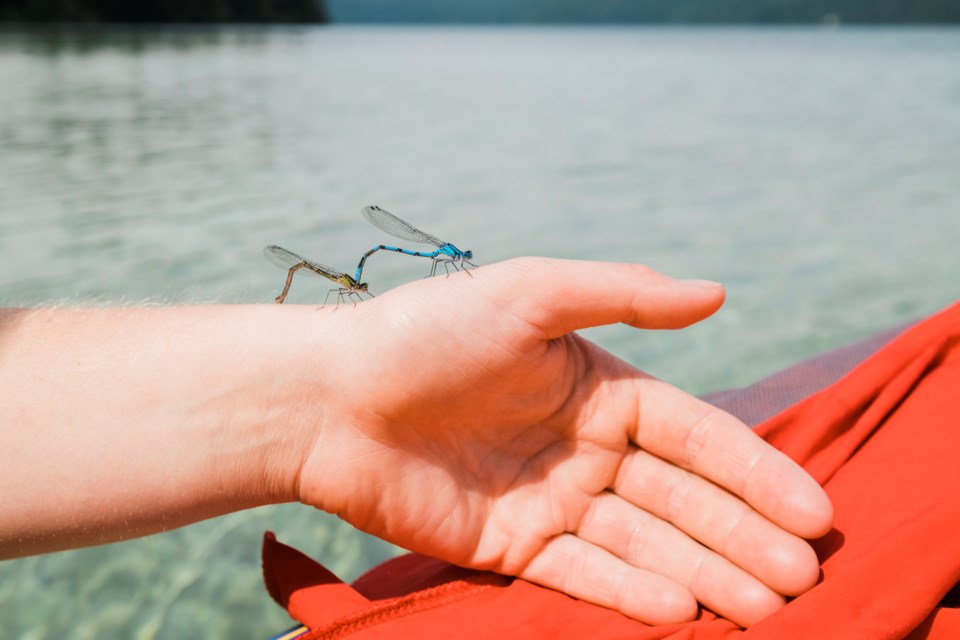In steep decline, Canada’s withering dragonfly populations are the target of a recent rescue mission being carried out by a growing army of citizen scientists.
, a new initiative by Ducks Unlimited Canada (DUC), allows everyday volunteers to log their dragonfly observations on and add to a database mapping out where species are located. In the first two weeks, 1,500 qualifying observations have been logged by 499 iNaturalist observers.
With their unimposing presence, dragonflies have literally flown under the radar for years as a species often uncredited for their role in ecosystems. Now, 16 per cent of 6,016 dragonfly and damselfly species are at risk of extinction, according to the International Union for Conservation of Nature.
In British Columbia, local dragonfly species are rare or at risk, according to the Ministry of Sustainable Resource Management.
James Paterson, a research scientist for DUC, said people should care about the conservation of dragonflies because they are an indicator species for the well-being of the wetlands they inhabit.
“Dragonflies are an excellent ‘canary in the coal mine’ for broader biodiversity conservation,” Paterson said. “They spend part of their life in the water and wetlands, and then part of their life flying through the air.”
Between 1970 and 2015, 35 per cent of wetlands globally were lost, according to the . Canada is home to a quarter of the world’s remaining wetlands and 5.6 per cent of B.C. is composed of wetlands.
These wetlands have 40 per cent of global species reliant on them and are disappearing three times faster than forests, according to DUC. Paterson said this is due to the clearing of land for agriculture and urban expansion.
“Historically, people have thought of wetlands as waste areas, where you just want to get the water away so that you can do something useful with it,” Paterson said. “But now we're realizing that those systems have so many benefits to human society.”
Bruno Oberle, director general of the International Union for Conservation of Nature, said in a press release that the importance of Canada’s wetlands can often be overlooked by everyday citizens.
“[Wetlands] store carbon, give us clean water and food, protect us from floods, as well as offer habitats for one in 10 of the world's known species,” Oberle said.
While some regions of B.C., such as the South Okanagan, have seen of up to 85 per cent, DUC has been successful in conserving or restoring 451,747 acres of wetlands through various projects.
Dragonfly data to help fill the void
Janine Massey, chief marketing and communications officer for DUC, said an essential part of Project Dragonfly is just getting people to explore their local wetlands.
“To really appreciate the importance of wetlands is to experience them,” Massey said. “Anything that gets people out, exploring and appreciating the incredible biodiversity that exists within wetlands is really helpful for us.”
The observations collected by citizen scientists through this project will help fill a void in data that would otherwise be difficult to collect, Massey said. She gave the example of a BC Parks project that saw a citizen scientist report the in 40 years.
“We've already, in recent years, seen people discover species that we didn't expect. Species that we didn't think were here,” Massey said. “It's completely happened through citizen science platforms.”
Paterson said to help protect wetlands and the species that inhabit them, action also needs to be taken at a national level. As home to such a large percentage of the world’s wetlands, he said Canada has a unique responsibility to conserve them that isn’t being met.
“In order to protect wetlands, we first have to have a picture of how many are left,” Paterson said. “We don't have a national inventory of where all those wetlands are, which we need to be able to see how fast they're declining [and] put conservation measures in place.”
After launching Project Dragonfly two weeks ago, Massey said 85 of 211 dragonfly and damselfly species in Canada have already been observed. She said by the time the project ends in August, she expects to have all 211 species recorded.
Massey added that if people aren’t passionate about dragonflies, perhaps they can be encouraged to get involved because of their distaste for a dragonfly's favourite meal: mosquitoes.
“I think that if you're not that enthralled with dragonflies, you can still get on board with the positive impact that they have.”
